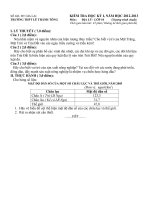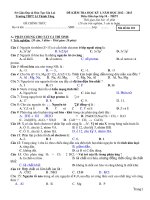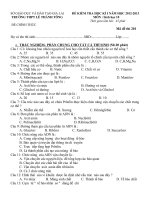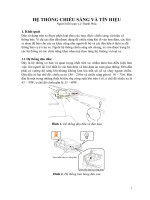CRUIS CONTROL SYSTEM , LE THANH PHUC
Bạn đang xem bản rút gọn của tài liệu. Xem và tải ngay bản đầy đủ của tài liệu tại đây (249.69 KB, 18 trang )
CRUISE CONTROL SYSTEM
Le Thanh Phuc
Faculty of Automotive Engineering
University of Technical Education Ho Chi Minh City
Email:
Introduction
•
•
Cruise control is an invaluable feature on American cars.
•
The cruise control system controls the speed of your car the same way you do - by adjusting the throttle position.
Without cruise control, long road trips would be more tiring, for the driver at least, and those of us suffering from
lead-foot syndrome would probably get a lot more speeding tickets.
2
CCS explanation
•
Hitting the on button does not do anything except tell the car
that you might be hitting another button soon.
•
The off button turns the cruise control off even if it is engaged.
3
CCS explanation
•
The set button tells the car to maintain the speed you are
currently driving.
•
If you hit the set button at 45 mph, the car will maintain your
speed at 45 mph.
4
CCS explanation
•
If you recently disengaged the cruise control by hitting the
brake pedal, hitting the resume button will command the car to
accelerate back to the most recent speed setting.
5
CCS explanation
•
Holding down the coast button will cause the car to decelerate,
just as if you took your foot completely off the gas.
6
CCS explanation
•
The brake pedal and clutch pedal each have a switch that
disengages the cruise control as soon as the pedal is pressed, so
you can shut off the cruise control with a light tap on the brake
or clutch.
7
CCS explanation
•
The cruise control system controls the speed of the car by
adjusting the throttle position, so it needs sensors to tell it the
speed and throttle position.
•
It also needs to monitor the controls so it can tell what the
desired speed is and when to disengage.
8
CCS explanation
•
•
Two cables connected to a pivot that moves the throttle valve.
One cable comes from the accelerator pedal, and one from the
actuator.
9
CCS explanation
•
Many cars use actuators powered by engine vacuum to open
and close the throttle.
•
These systems use a small, electronically-controlled valve to
regulate the vacuum in a diaphragm.
10
CCS explanation
•
•
Adaptive cruise control is similar to conventional cruise control in that it maintains the vehicle's pre-set speed.
•
This is achieved through a radar headway sensor, digital signal processor and longitudinal controller.
However, unlike conventional cruise control, this new system can automatically adjust speed in order to maintain a
proper distance between vehicles in the same lane.
11
CCS operation
•
In a standard cruise control system, the speed of the vehicle is controlled to a desired value using the throttle control
input.
•
The longitudinal control system architecture for the cruise control vehicle will be designed to be hierarchical, with an
upper level controller and a lower level controller.
12
13
•
The upper level controller determines the desired acceleration for the vehicle.
•
The lower level controller determines the throttle input required to track the desired acceleration.
14
UPPER LEVEL CONTROLLER FOR CRUISE CONTROL
•
A typical algorithm used for the upper controller is PI control using error in speed as the feedback signal
15
UPPER LEVEL CONTROLLER FOR CRUISE CONTROL
•
The plant model for the upper controller is the transfer function between desired acceleration and actual vehicle
speed
16
•
The PI controller is:
17
PID controller circuit
18









